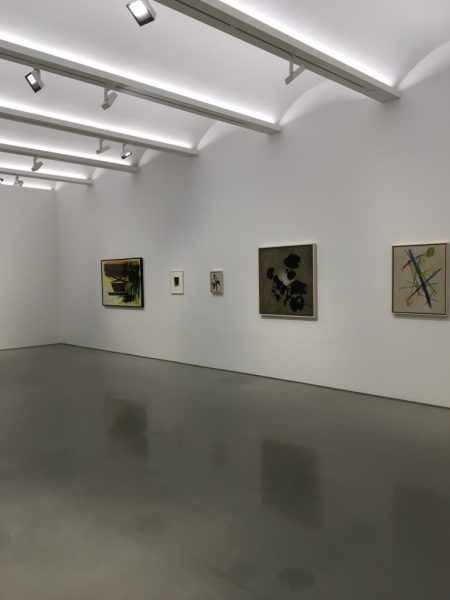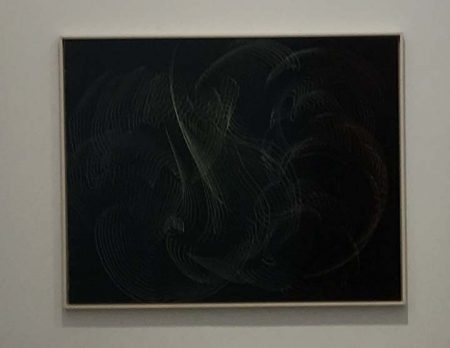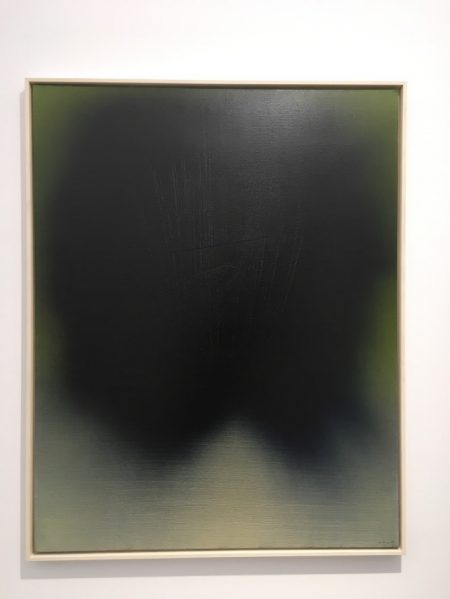Perrotin’s opening exhibition in New York for 2018, Hans Hartung: A Constant Storm. Works from 1922 to 1989, featured a retrospective assessment of one of the pioneers of Lyrical Abstraction in Europe, including over 60 major works. This exhibition—which was on view from January 12 until February 18—marked the most extensive presentation of the artist’s oeuvre since 1975.[1] Therefore, the show presented a challenge and opportunity to curator Matthieu Poirier to strategically organize works in order to chart Hartung’s artistic evolution, find core motifs across his seven-decade body of work, and properly situate his corpus in the larger history of twentieth-century abstraction—a task that is arguably more appropriate now having the critical temporal distance necessary to make such an evaluation. Three central themes united this exceptional panoply of works and served as the animating forces of the exhibition: a play with scale and positioning that absorbs the viewer; a balance between spontaneous and controlled marks or brushstrokes; and a posing and answering of the question of the role of the artist through varied applications of the graphic mark.
The Quantum and the Cosmic
Hartung’s shuttling back and forth between the quantum and the cosmic became increasingly more apparent as viewers made their way across the two floors of Perrotin’s Orchard Street venue.[2] Early in the exhibition, guests encountered T1938-30 (1938) (Figure 1), which contains biomorphic forms or splotches resembling contagions, cells, or bacteria. Similarly, T1964-H44 (1964), an imposing work that engulfs the viewer through the void that is present across much of the surface, was positioned in the last section on the first floor. Embedded throughout this black abyss are small bumps in the canvas (possibly simulating seeds or embryos) and taches of paint that form microscopic creatures redolent of protozoa. On the upper story, three canvases T1974-H27 (1974), T1973-H12 (1973), and T1976-E22 (1976) all resemble genetic material placed underneath lab instruments.
In contrast to these examples where Hartung presents the viewer with a remarkably close examination of lifeforms through abstraction on a grand scale, there are a fair number of works that explore seemingly organic material on a universal scale.
Across the first three rooms of the exhibition, some of Hartung’s paintings have linear forms or matrices that call to mind planetary diagrams. As well, T1977-R42 (1977) seems to index time-elapsed photographs that track the movement of stars through parallel, curving lines with black forms scattered about the canvas. Hanging in the same room as T1964-H44 (1964) were T1966-E18 (1966), T1967-H20 (1967), T1967-H22 (1967), all of which were united in their use of darkness. However, Hartung’s use of color in the latter three paintings resemble auroras, nebulae, and the cosmic raw material necessary for the creation of life.[3] The abstract patterns across T1985-H10 (1985), T1983-R6 (1983), and T1989-H35 (1989) upstairs also seem to explore the notion of raw matter, connecting the act of painting, the act of representation as a generative act. In T1985-H10 (1985) (Figure 2) black paint seems to have been petrified and suspended in air, appearing as artistic detritus for the potential use of creation. Specks of paint swirl about on a light blue ground in T1983-R6 (1983), as if serving as a representation for inchoate universal debris that coalesces to form celestial bodies. T1989-H35 (1989), which calls to mind Pat Steir’s work, contains areas of bare canvas, patches of solid color, flecks of paint, and striations. These differing methods of applying paint to the canvas explores the construction of images, an introspective exercise into the act of painting and representation itself. Each visual component of T1989-H35 (1989) might be understood as relating to the different types of stellar material necessary for the genesis of life on a monumental scale.[4] Taken together, Poirier has helped draw out an extensive visual dichotomy between the microscopic and macroscopic, making exceptional use of Hartung’s large abstract paintings.[5]
It is important to understand Hartung’s engagement with this sort of imagery within the larger context of mid-century abstraction, as it developed on both sides of the Atlantic. Hartung’s work is often characterized as a forerunner to Action Painting and the artists who formed the New York School. Like the Abstract Expressionists who came after Hartung, the German-French painter saw abstract painting as a means to “elicit in the viewer a sensation that was richer than what a mere image could produce, a sensation that was physical, tactile, and muscular.”[6] Both Hartung and American abstractionists were interested to varying degrees in Jungian psychology, specifically Carl Jung’s ideas about a collective unconscious, using symbols to evoke certain emotions in the viewer, and a universal image, one accessible to all and relating to humanity’s primordial beginnings.[7] By playing with scale and setting his works in dark recesses—either the abyss of space, the mind, or even the womb—Hartung leads viewers to visualize forms, to contemplate, to participate in the creative act because the total image is not supplied. For instance, in T1967-H20 (1967) the edges of the canvas are filled with light while the center is dark; the place where subject or narrative is supposed to occur is left empty. This subversive action creates a type of viewing that is affective, and encourages the spectator to provide the content. Keeping this larger context in mind helps explain some of Hartung’s deep engagement with scale, positioning, and oblique references to microscopic and cosmic material. As well, Hartung’s deployment of radical abstract painting can also be partially understood due to the traumatic historical events surrounding the second World War, a point I will return to at the conclusion of this essay.
Tension between Two Poles of Practice
In addition to the indeterminacy of scale, each masterwork in the exhibition manifests a balance between impulsive and controlled marks, as noted in the exhibition statement.[8] This dialectic can be better understood as two poles of practice that have a rather long lineage in the canon of western art history: disegno versus colore, neat manner versus rough manner, painterly versus linear. Each respective style signifies a discrete set of associated values, ideas, and beliefs due to how that manner has been used historically by past artists. Hartung’s use of more painterly, expressive, and improvised gestural strokes stem from a physical impulse and desire to be liberated from the burden of imagery or figuration.[9] This mode of representation, which can loosely be described as Lyrical Abstraction, has historic roots to explorations of the power of nature, subjectivity, chaos, and various iterations of the concept of the sublime. In Jean Clay’s Faces of Modern Art from 1969, he explains that “as Hartung saw it, an artist must be open to the multiple forces that constitute the world, that affects—sometimes in an obscure way—human sensibility, and then transmit those forces on the canvas…Cosmic forces…organic forces (‘Be it the throbbing of blood or the driving growth of a stem’), the multifarious sensations stirred by nature…”[10] In contrast to this lyricism, Hartung’s utilization of regulated marks, strokes, or taches point to an attempt to impose order on chaos, and relate to elements of Geometric Abstraction.[11] Line, as one of the fundamental formal components of painting, has traditionally signified rationality and reason due to its ties to perspective, design, and architecture (which is humanity’s attempt to impose organization on the landscape).
These two poles of practice—occupying the same pictorial space across nearly every canvas—serve as a visual metaphor for the universal struggle between order and chaos, and humankind’s plight of reconciling rationality with irrationalism, the subjective with the objective.[12] T1948-15 (1948) (Figure 3) is a strong representation of this internal struggle: pure geometric shapes are covered over with organic, free-flowing lines in circular, elliptical, and ovoid shapes, once again calling to mind cosmological references. Considering this tension between the two poles of practice, the title of the exhibition becomes a bit more clear because both artist and viewer are engaged in a constant storm of emotional impulses and systems of reason—attempting to weather physical and mental forces and emerge intact.
The Tache as an Extension of the Artist
Hartung’s masterful and versatile use of line was perhaps one of the most compelling and salient aspects of the exhibition. The stroke, the graphic mark, the daub, the tache all form variants of line and point to the presence of the artist. Hartung’s work is indissolubly linked to Art Informel and Tachism, movements that explored the limits and restrictions of figuration and questioned the role of the artist.[13] Tache is a polyvalent word that can be translated from the French either as stain or task. With the latter interpretation, this felicitous word calls upon creator and viewer to consider the role or task of the artist through the application of the graphic mark. Perrotin’s exhibition enabled visitors to retrospectively see Hartung struggle with this question and attempt to formulate pictorial answers through diverse markings across his impressive body of work.
There is an energy and astounding indexical power in how Hartung manipulates line. One of the primary feats that Poirier managed to accomplish through this exhibition was to forcefully and clearly demonstrate the evolution of line across Hartung’s career. This evolution ranges from thick, gestural strokes that form an oblique language of accents and diacritical marks in the first section (T1951-3 (1951)) (Figure 4) to more elegant, refined, and delicate marks with lyrical or calligraphic qualities that comprise the middle parts of the show (T1962-L34 (1962)) (Figure 5) to lines that are embedded, incised into the canvas, (T1967-H20 (1967)) (Figure 6).[14] By the time viewers reached the last room of the exhibition, which contains works from the artist’s last decade of production, there was a conspicuously less fluid and elegant use of line, and the use of black had largely come to replace the prominent role previously held by line. Works in this section had a strong visual, emotional, and intellectual affinity with the works of Mark Rothko and Barnett Newman. Collectively then, Hartung’s diverse use of line indexes both the artist’s presence and movement along with a host of potential forms and subjects, including threads of fabric, metal coils, ribbons of film, roots and blades of grass, lines of computer code, and bands of genetic sequencing.
A Role for Abstraction Today?
In short, Perrotin’s recent exhibition of Hans Hartung’s work was a chance for curator Matthieu Poirier to re-introduce American audiences to one of the vanguards of Lyrical Abstraction at a fitting historical moment. I believe Poirier was largely successful in defining Hartung’s role in twentieth-century abstraction, and delineating how the artist developed a formal lexicon across his long artistic career that drew upon elements of both lyrical and geometric abstraction. The visually rich ensemble of paintings prompted guests to think about the relationship between the quantum and the cosmic, humanity’s perilous position between those two terminal points, and abstraction as a viable mode of representation to confront universal human themes of violence, tragedy, chaos, and turmoil.
It is worth remembering that abstraction in part became a dominant mode of representation in the twentieth century because of the horrific historical events surrounding the first and second World Wars. Artists on both sides of the Atlantic found themselves longing to respond to and represent these events, yet figuration seemed woefully inadequate for such a task; there seemed to be a futility of figuration in being able to capture and sufficiently represent carnage on such a scale.[15] In a diary entry from 1915, the Swiss-German painter Paul Klee stated, “[the] more horrifying this world becomes, the more art becomes abstract; while a world at peace produces realistic art.”[16] To my mind, it is important to understand Hartung’s images within this larger postwar context. In Jean Clay’s 1969 book, Hartung is quoted as saying that he wanted his marks or strokes to be “strong enough to reach not only the next generation, but the generations after that. I sometimes think that young people, later, much later, may find an echo and an answer in our works.’”[17]
In our contemporary moment, where many American painters are electing to confront resurgent nationalism, xenophobia, and a host of other socio-political issues through their artistic practice, Hartung’s approach to representation offers one that can potentially be appropriated and modified to address the chief concerns of the twenty-first century. Yet, a general survey of biennials along with contemporary art exhibitions at major museums and galleries reveals that painters are largely choose not to engage with abstraction as a means to respond to or represent acts of violence or injustice. Rather, figurative painting seems to remain prevalent, perhaps because it has the highest potential to engage directly in socio-political discourses, and be interpreted more readily by mass audiences than abstract works. That is not to say that the abstract formal vocabulary Hartung meticulously developed over his lifetime is not useful. In fact, this abstract language that simultaneously embodies lyrical and geometric qualities may indeed prove to be useful in the near future as present cultural practitioners continue to formulate their own respective artistic languages of resistance and criticism in a world where politics and aesthetics are becoming even more entwined.

Hans Hartung, “T1938-30”, 1938. Oil on wood, 100 x 100 cm (39 3/8 x 39 3/8 inches).

Hans Hartung, “T1985-H10”, 1985. Acrylic on canvas, 114 x 146 cm (44 7/8 x 57 1/2 inches)

Installation view of exhibition (Room 1), Hans Hartung, “T1948-15” [2nd from left], 1948. Oil on canvas, 97 x 146 cm (38 3/16 x 57 ½ inches). Collection of the Museum of Modern Art.

Installation view of Exhibition (Room 1), Hans Hartung, “T1951-3” [far left], 1951. Oil on canvas, 96 x 145 cm (37 13/16 x 57 1/16 inches). Collection of the Albright-Knox Art Gallery.

Hans Hartung, “T1962-L34”, 1962. Vinylic paint on canvas, 142 x 180 cm (55 7/8 x 70 7/8 inches).

Hans Hartung, “T1967-H20”, 1967. Vinylic paint on canvas, 180 x 142 cm (70 7/8 x 55 7/8 inches).
–Tony Huffman
[1] Hans Hartung: Paintings, 1971-1975. Exh. Cat. New York: Metropolitan Museum of Art, 1975. Matthieu Poirier notes that the Met’s 1975 show offered too limited a historical vision of Hartung’s career because it only showed his most recent work, see Matthieu Poirier, Hartung. A Constant Storm, edited by Raphael Gatel and Manon Lutanie, translated by Charles Penwarden. Beveren-Leie, Belgium: Cassochrome, 2018), 26.
[2] Hartung’s play with scale can be described in cinematographic terms as changing the focal length or the view of angle.
[3] It is worth noting how Hartung’s numbering system for his paintings is similar to how galaxies are catalogued by observatories and astronomical databases through the Messier catalog method and the New General Catalogue (NGC) system. While the system was maintained by his studio assistants and largely put in place to help preserve his work for posthumous acclaim and documentation, it is worth considering how each canvas might be understood as its own autonomous universe, a world of abstract forms that invite viewers to gaze and contemplate.
[4] In this sense, the assembly of paintings that engage with cosmic imagery in an abstract manner relates to the title of the exhibition: A Constant Storm. The title conjures up notions of the violence and destruction of natural phenomena, but at the same time the restorative and re-generative power that storms hold to bring about new life.
[5] As explained in the catalogue essay, Hartung developed an early passion for optics and cosmography, see Poirier, Hartung. A Constant Storm, 25.
[6] Ibid., 21-22.
[7] Poirier touches upon this notion when he talks about the absence of identifiable objects, scale, and distance, and how this is meant to induce a singular aesthetic experience in the viewer. Ibid., 22-23.
[8] Ibid., 16-17.
[9] Poirier notes that the immediacy of Hartung’s paintings is a trick: the aesthetic impact of speed is a result of a deliberate system of enlarging and translating, a system the artist used between the 1930’s and 1960. Ibid.
[10] Jean Clay, “Hans Hartung,” translated by Charles Penwarden, from Poirier, Hartung. A Constant Storm, 238 [Italics original]. Clay’s original text, Visages de l’art moderne, was published in 1969 by Éditions Rencontre.
[11] As Poirier notes in the catalogue essay, early on in his artistic development Hartung was interested in the absolute articulation of forms, the golden section, harmony, proportion, and learning how to create order out of disorder. Poirier, Hartung. A Constant Storm, 20.
[12] It is important to note that precisely because Hartung incorporated both of these approaches (Geometric and Lyrical Abstraction) into his artistic practice historians of twentieth-century art have had difficulty in classifying him; Hartung, to this day, still tends to defy the taxonomies used to group abstract painters.
[13] Hartung is credited with actually coining this term. Poirier, Hartung. A Constant Storm, 29.
[14] These incisions reveal Hartung’s early interest in the raw woodcuts of Die Brücke artists, Poirier, Hartung. A Constant Storm, 18. Moreover, the earlier works where the gestural strokes resemble accent marks (prefiguring Franz Kline’s paintings) relate to how language is an attempt to impose order, system, rationality on chaotic utterances and sounds. This connection further underscores Hartung’s intense engagement with representing the tension of rationality versus irrationality.
[15] Hartung was German by birth, but was expelled from his homeland by the Nazis because his art was considered degenerate. He fought in the French Foreign Legion and lost a leg in battle while carrying a wounded man on the front lines in Alsace. After the war, he was honored with the prestigious Croix de Guerre by the government of France and naturalized as citizen of the French Republic. Poirier, Hartung. A Constant Storm, 15.
[16] Paul Klee Diary entry #951 (1915), The Diaries of Paul Klee, 1898-1918. University of California Press, 1968. A variant of this quote also appeared in a speech by William Van Dusen Wishard entitled “Between Two Ages: The Meaning of Our Times.”
[17] Jean Clay, “Hans Hartung,” from Poirier, Hartung. A Constant Storm, 240.